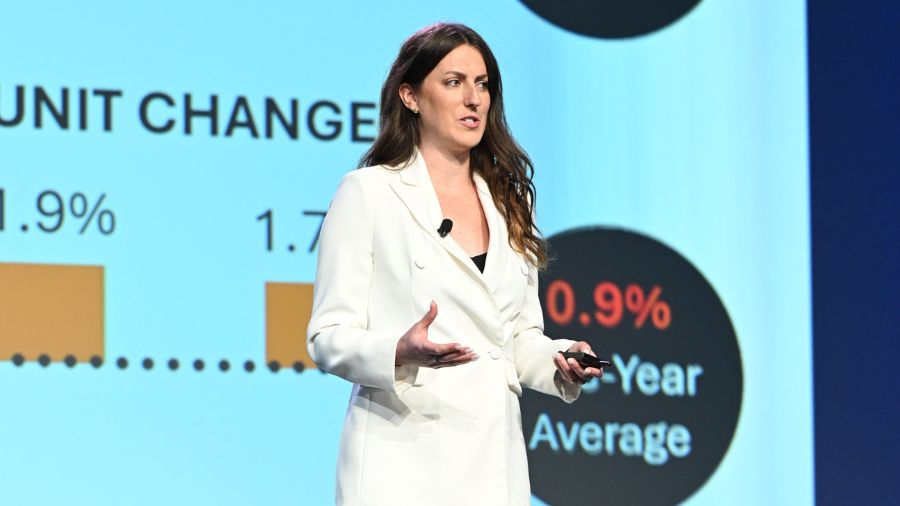
If there was an overriding theme to the 2025 Restaurant Leadership Conference, it had to be uncertainty.
Convened in the three-month lull between President Trump’s latest tariff proclamation and the July start date for stiff fees on imports from 60 nations, the gathering repeatedly touched on what chains are or should be doing to weather the impact. Yet there was no agreement on what form the duties will ultimately take, nor how much of a wallop they’ll prove to be.
The restaurant industry isn’t waiting for clarity, according to research aired during the four-day event. About 78% of operators have already taken defensive measures, Technomic revealed in a session intended as a preview of what’s ahead for the food-away-from-home business.

Rich Shank, Technomic
“Seventy-four percent are confident the changes they’ve made already and the changes they’re contemplating will be sufficient” to offset the impact, said Rich Shank, Senior Principle and VP of the research company.
He was one of several speakers who suggested the industry’s trial-by-fire during the pandemic has left operators confident they can plot an effective strategy for this crisis, too.
The most common planned defense, Shank revealed, is relying on menu-price increases to preserve margins.

Lisa Jennings, National Restaurant News, Jim Balis, Sizzling Platter, Robin Robison, Thrive Restaurant Group
That might be much easier said than done, suggested Jim Balis, Board Leader of multi-brand franchisee Sizzling Platter.
The company, whose brands range from Wingstop to Red Robin, computed how the tariffs might affect its profits. Balis attested that Sizzling has no better reader than any other party on what the surcharges may be when they’re imposed in July. But the indications are that the tariffs will likely cost about 100 to 150 points of EBITDA, or earnings before interest, taxation, depreciation or amortization.
"What kind of price would you need to offset that? We’re thinking it’ll be about 15%,” Balis said.
Other operators indicated they’re stockpiling non-perishable supplies to avert shortages or bruising spikes in prices. Balis’ panel mate in a general session, Robin Robison of Thrive Restaurant Group, revealed that her charge has taken that approach.
“We made a decision to purchase all of our small wares to mitigate the risk,” said the president of Thrive’s Emerging Brands Division, which operates the HomeGrown daytime dining concept.
Some suppliers noted how customers had accelerated their purchases of tableware and linens, for which China now serves as a major source. Although President Trump delayed what he called reciprocal tariffs on imports from countries that impose a surcharge on U.S. goods, he did not extend the delay to China. Indeed, the White House raised the duties on all products from that nation to 145%.
Comments heard both from the stage and in casual conversations were in line with a National Restaurant Association report that imports of foods, beverages and animal feed had jumped 4.3% in January, to $20.04 billion. Inbound shipments of cocoa beans, wine, beer and meat products showed the sharpest jump.
The surge was part of a 12.3% leap in overall imports during the month, to $329.55 billion. The heightened activity raised the national trade deficit to the highest level ever recorded for the U.S. Trump’s tariff plan is intended to close that gap.
Other conference participants acknowledged that the uncertainty over how large and extensive the tariffs will ultimately prove to be had prompted their organizations to interrupt business as usual.
A woman who identified herself as a member of Panda’s management team shared in a breakout session that the Asian restaurant group was deferring expansion until the dust clears. Instead of building stores, she said, the operation was warehousing sites for the time being.

Lizzy Freier,Technomic
Industrywide, expansion will likely remain steady at 1.7%, according to Lizzy Freier, Technomic’s Senior Director of Menu Research & Insights.
What’s an operator to do?
Her colleague, Rich Shank, offered a formula of sorts to help operators navigate the uncertainty they face. He cited three factors that will be essential for growth: Strong brand identify, cultural relevance, and innovation.
“All three of these things are key to what’s going to happen,” Shank said.
The proof, he said, is in the data. Chains judged by Technomic to overachieve on those three fronts have enjoyed a 7.5% growth in their business, while brands that merely matched competitors’ performance in those areas lagged behind the pack in improving their fortunes.
The Restaurant Leadership Conference was held in Scottsdale, AZ, from April 13 – 16. It is presented annually by Informa, the parent company of Restaurant Business, Nation’s Restaurant News, Supermarket News, and CSP.
As Managing Editor for IFMA The Food Away from Home Association, Romeo is responsible for generating the group's news and feature content. He brings more than 40 years of experience in covering restaurants to the position.